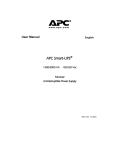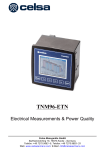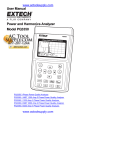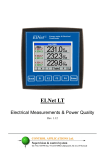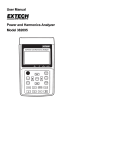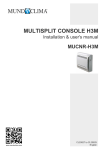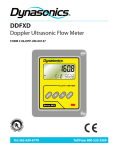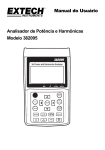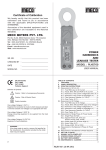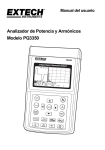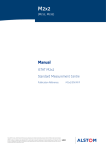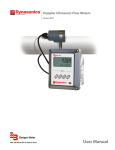Download POWER AND HARMONICS ANALYZER MODEL : PHA5850
Transcript
® ® Certificate of Calibration We hereby certify that this product has been calibrated and found to be in accordance with the applicable SPECIFICATIONS and STANDARDS. Accuracies of the standard equipment used in this calibration are traceable to the National Standards. MECO METERS PVT. LTD. Plot No. EL-60, MIDC Electronic Zone, TTC Industrial Area, Mahape, Navi Mumbai - 400710 (INDIA) Tel : 0091-22-27673311-16, 27673300 (Board) Fax : 0091-22-27673310, 27673330 E-mail : [email protected] Web : www.mecoinst.com SR. NO. POWER AND HARMONICS ANALYZER : CHECKED BY : DATE : MODEL : PHA5850 MODEL NO. : USER MANUAL EN 61010-2-032 CAT III 600V Pollution Degree 2 Definition of Symbols : Caution : Refer to Accompanying Documents Don’t use the flexible current probe before you read the following instructions. 1. Don’t install the flexible current probe around bare conductors carring a voltage from 30V to 600V unless you are wearing protective clothing and glove suitable for high-voltage work. Caution : Risk of Electric Shock 2. Always inspect and check any damage of the current probe assembly before usage. Don’t use the flexible current probe if any damage is found. Double Insulation 3. Don’t use the flexible current probe on circuit rated higher than 600V in installation category III. Over-voltage Category III (CAT III) : Equipment in fixed installations. WARNING : If the clamp meter is used in a manner Not specified by the manufacturer, the protection Provided by the clamp meter may be impaired. Please read the followinq instructions before usaqe 2 1. Do not operate in wet or dusty environments. 2. Do not operate in presence of combustible or explosive gas 3. Do not touch exposed metal parts, unused terminals. 4. Consider the use of rubber glove In operation. 5. Do not operate in excess of AC 500V (Phase to Neutral), or AC 600V (Phase to Phase) 6. Do not operate when the unit seems to be mal-functioning 3 01072011 1 III.16 Down Load Transient Data ................................... 41 TABLE OF CONTENTS I. FEATURES ....................................................................... 6 II. PANEL DESCRIPTION .................................................... 7 III.17 Data Logging of Power Data (3P4W, 3P3W, 1P2W, 1P3W) ............................... 42 III.18 Down Load Power Data ........................................ 43 CURRENT PROBE ......................................................... 12 III. III.19 Data Logging of Harmonics .................................. 44 OPERATING INSTRUCTIONS ..................................... 15 III.20 Down Load Harmonics Data ................................ 45 III.0. Set up before operation ........................................ 17 III.1. Power Quality of a 3 Phase 4 Wire System ......... 19 III.2 Power Quality of a 3 Phase 3 Wire System ......... 21 III.3 Power Quality of a Single Phase System ............. 23 III.4 Power Quality of a 1 Phase 3 Wire System ......... 24 III.5 Measurement of a System with CT or VT ........... 25 III.6 Harmonic Analysis of Voltage or Current ............. 27 III.7 Display the Phase Angle of Harmonics ................ 29 III.8 Measurement of Maximum Demand .................... 30 III.9 Waveform of Voltage and Current ........................ 31 III.10 Waveform of Voltage Only .................................... 32 III.11 Graphic Phasor Diagram ...................................... 33 IV. HARDCOPY OF SCREEN ............................................. 46 V. READ THE SAVED SCREEN ........................................ 47 VI. SET THE CT AND VT RATIO ........................................ 48 VII. SET THE TIME INTERVAL FOR MAXIMUM DEMAND49 VIII. SET THE SAMPLING TIME FOR DATA LOGGING ... 50 IV. SET THE CALENDER CLOCK ..................................... 51 X. PROTOCOL OF RS-232C INTERFACE ...................... 51 XI. SPECIFICATIONS (23°C ± 5°C) .................................... 52 XII. BATTERY REPLACEMENT .......................................... 61 XIII. MAINTENANCE & CLEANING ..................................... 62 XIV. NOMENCLATURE ......................................................... 63 III.12 Phase Sequence of a 3 Phase System ............... 35 III.13 Balance and Unbalance 3 Phase (3P3W, 3P4W) Power Source System .......................................... 36 III.14 Balance and Unbalance 3 Phase (3P3W or 3P4W) Load System ......................................................... 37 III.15 Transient Capture (Dips, Swells, Outage) ........... 38 4 5 1. FEATURES l l l l l l l l l l l l l l l l l l l l l l l l l l l 6 Analysis for 3P4W, 3P3W, 1P2W, 1P3W True RMS value (V123 and l123 ) Activs Power (W, KW, MW, GW) Apparent and Reactive Power (KVA, KVAR) Power Factor (PF), Phase Angle (φ) Energy (WH, KWH. KVARH, PFH) Current measurement from 0.1mA to 1000A, capable of analyzing IT standby power consumption to the maximun demand ot a factory Display of 35 Parameters in One Screen (3P4W) Programmable CT (1 to 600) and PT (1 to 3000) Ratios Display of Overlapped Voltage and Current Waveform Average Demand (AD in W, KW, MW) Maximum Demand (MD in KW, MW, KVA, MVA) with Programmable Period Harmonic Analysis to the 99th Order Display of 50 Harmonics in one Screen with Waveform Display of Waveform with Peak Values (1024 Samples / Period) Analysis of Total Hamonic Distortion (THD-F) Graphlc Phasor Diagram viilh 3 Phase System Parameters Capture 28 Transient Events (Time+ Cycles) with Programmable Threshold (%) DlP, SWELL and OUTAGE are included in transient events. 3 Phase VoItage or Current Unbalance Ratio (VUR, IUR) 3 Phase Vollage or Current Unbalance Factor ((d0%, d2%) Calculated Unbalanced Current through Neutral Line (In) 512K Memory with Programmable Interval (Sampling time from 2 to 3000 seconds, 17000 records for 3P4W system) Output of Wavefam, Power Parameters and Harmonics at Command Large Dot Matrix LCD Display wilh Backlight Optical Isolated RS-232C to USB Interface Built in timer and calender for data logging II. PANEL DESCRIPTION 1 3 2 4 5 6 7 7 01072011 2 1. Input Terminal for Neutral Line (Voltage) 2. Voltage Input Terminals for Each Phase (V1, V2, V3) 3. Extemal DC 12V Input (The AC adaptor must be 600V isolated) Press this button to exit transient detection 4. Current Input Terminals for Each Phase (l1, l2, l3) 5. LCD Display 6. Setting in LCD Screen Press this button to perform transient detection 7. Buttons 8. RS-232C Window 9. Stand Holder 10. Stand Press this button to hold the data displayed in LCD, press again to continue operation. 11. Battery Cover 12. Battery Compartment Press this button to start measurement of harmonics is magnitude. 8 9 Press this button to select V1, l1, V2, l2, V3, or 13 for harmonics analysis Press this button for the voltage or current input range Press this button to select the parameter to be adjusted Press this button to increment value by one. Hold the button for two seconds or more to speed up the increment. Press this button lo decrement value by one. Hold the button tor two seconds or more to speed up the increment. Press this button to start to data logging. Press it again to stop logging. The sampling interval is displayed in LCD pointed by indicator. In the mode of power measurement, press this button to display the phasor diagram. In the mode of harmonic analysis, press this button to display phase angle instead of magnitude. Press this button to turn the back light on. Press it again to turn the back light off. Press this button to start measurement of power parameters. Press this button to display waveform of voltage and current. Press this button to display waveform of voltage only. In the mode of harmonic analysis, press this button to move the cursor left to the previous order. In the mode ol harmonic analysis, press this button to move the cursor right to Ihe previous order. 10 In the mode of power parameter measurement, press this button to select appropriate system (3P4W, 3P3W, 1P2W or 1P3W) the mode of displaying waveform, press this button to select (l1), (V2, l2) or (V3, l3). Press this button to turn the power on or off. 11 01072011 3 PHA5850 Current Probe ‘A’ (1/10/100A AC) PHA5850 Current Probe ‘B’ (10/100/1000A AC) 1. Jaw Assembly 2. Trigger 3. Range Selector 4. 6 pin mini DIN connector 1. Jaw Assembly 2. Trigger 3. Range Selector 4. 6 pin mini DIN connector NOTE : To setup 100A current probe as selected probe, press the SETUP button to select CLAMP. When the CLAMP is reverse video, press the s or t button to select 100. NOTE : To setup 1000A current probe as selected probe, press the SETUP button to select CLAMP. When the CLAMP is reverse video, press the s or t button to select 1000. 12 PHA5850 Flexible Current Probe ‘C’ (300/3000A AC) 13 III. Operating Instructions NOTE : Select the correct clamp in the setup menu. When the current probe is connected to the power analyzer, power analyzer will automatically detect the range selected. NOTE : Select the correct frequency (Hz) in the setup menu. 1. Coupling Assembly 2. Flexible Loop 3. Mini-Din connector for output 4. Output range selected switch WARNING : All the current probes connected to the power analyzer must be of the same model and same range. Mixed models and different ranges selected will cause incorrect result of measurement. NOTE : To setup 3000A current probe as selected probe, press the SETUP button to select CLAMP. When the CLAMP is reverse video, press the s or t button to select 3000. 14 15 01072011 4 NOTE : Please pay special attention to the flexible current probes connected to power analyzer. III.0. Setup before operation 1 2 3 4 5 6 7 8 9 10 11 12 13 14 15 16 17 A. Press setup button to enter setup screen. Press setup again to select the item for setting (the selected item will be displayed in reverse video). B. After selecting the item, press s or t button to leave setup mode. C. After finising setting up, press exit button to leave setup mode. 1. 2. 3. Connect the flexible probes around the conductor. Make sure the current flowing direction is in consistent with the arrow marked on the probe coupling. If the flexible current probe is connected in the right orientation, the correct phase will be displayed in the oscilloscope. Keep the probe coupling more than 25mm away from the conductor. WARNING : Always wear appropriate gloves in operation. 16 18 2. Show the total logged data in the analyzer max. 85 logging data. 3. Rec Date : show the starting logging time of the 1st downloaded file. 4. Hz : setup the frequency (50, 60 and auto) of the system. 5. PT : setup PT value 6. CT : setup CT value. 7. Sec : setup the interval seconds of logged data. 8. Clamp : setup the clamp selected (100A, 1000A or 3000A) 9. MD Time : setup the time of maximum demand (1~60 min) 10. Trans Ref : setup the transient voltage (which will be automatically changed in accordance with PT) 11. SDVP : setup upper and lower limits % of transient voltage detection. 12. Year : setup year of calender clock. 13. Month : setup month of calender clock. 14. Date : setup date of calender clock. 15. Hour : setup hour of calender clock. 16. Minute : setup minute of calender clock. 17. Second : Second can displayed only (it can not be adjusted). 1. Select the data for download H means harmonics. H in reverse video means hold screen data (if the data is the one you want, you can press hold button to display the data and press hold button again to exit. P means power data which can be referance for downloading, the data in order is 0~84. 17 III.1. Power Quality of a 3 Phase 4 Wire (3P4W) System 3P4W a. Turn the power on. Press the POWER and the 1φ3φ buttons to select the 3P4W system. The type of systern will be displayed at the left bottom corner in the LCD. b. Connect the four test leads to the vollage terminals V1, V2, V3 and the VN (Neutral) of the system. 19 01072011 5 c. Connect the test leads to L1, L2, and L3 of the 3P4W system. d. Connect the three current probes to the power analyzer input terminal l1, l2, and l3. e. Clamp on to the L1, L2, and L3 of the 3P4W system. Make sure the current flow from the front of the current probe to the back of it. f. All parameters of the system will be shown in LCD. Ill.2. Power Quality of a 3 Phase 3 Wire ( 3P3W) System For the meaning of each parameter, refer to XIV. Nomenclature. 3P3W 20 21 a. Turn the power on. Press the POWER and the 1φ3φ buttons to select the 3P3W system. The type of system will be displayed at the bottom right of the LCD. Ill.3. Power Quality of a Single Phase (1P2W) System 1P2W b. Connect the four test leads to the voltage terminals L1, L2 and L3 of the system. c. Connect the test leads to L1, L2 and L3 of the 3P4W system. d. Connect the three current probe to the power analyzer input terminal l1, I2 and l3. e. Clamp on to the L1, L2 and L3. Make sure the current flow from the front of the current probe to the back of it. f. All parameters of the system will be shown in LCD. a. Turn the power on. Press the POWER and the 1φ3φ buttons to select the 1P2W system. The type of system will be displayed at the bottom right of the LCD. b. Connect the four test leads to the voltage terminals L1 and VN (Neutral) of the system. c. Connect one current probe to the power analyzer input terminal l1. d. Clamp on to the L1. Make sure the current flow from the front of the current probe to the back of it. e. All parameters of the system will be shown in LCD For the meaning of each parameter, refer to XIV. Nomenclature. 22 For the meaning of each parameter, refer to XIV. Nomenclature. 23 01072011 6 III.4 Power Quality of a 1 Phase 3 Wire ( 1P3W) System III.5 Measurement of a System with CT or VT 3P4W+CT+VT 1P3W a. Turn the power on. Press the POWER and the 1φ3φ buttons to select the1P3W system. The type of system wilI be displayed at the bottom right of the LCD. b. Connect the four test leads to the voltage terminals L1, L2 and the VN (Neutral) of the system. c. Connect the two current probe to the power analyzer input terminal l1 and I2. d. Clamp on to the L1 and L2. Make sure the current flow from the front of the current probe to the back of it. e. All parameters of the system will be shown in LCD. a. Turn the power on. Press the POWER and the 1φ3φ buttons to select the 3P4W system. The type of system wilI be displayed at the bottom right of the LCD. b. Connect the four test leads to the secondary voltage terminals L1, L2, L3 and the VN (Neutral) of the system. c. Clamp on to the secondary coils of L1, L2, and L3. Make sure the current flow from the front of the current probe to the back of it. d. Press the SETUP button several times until the CT symbol is shown in reverse video in LCD. 19 24 e. Press the s or t button to increment or decrement the RATIO specified by the CT. For the meaning of each parameter, refer to XIV. Nomenclature. 25 III.6 Harmonic Analysis of Voltage or Current f. Press the SETUP button several times until the VT symbol is shown in reverse video in LCD. (Normal Voltage without Distortion and Harmonics) g. Press the s or t button to increment or decrement the RATIO specified by the VT. (Distortion Current with Harmonics) h. Press EXIT to return to POWER mode. All the parameters of the system will be shown in LCD. For the meaning of each parameter, refer to XIV. Nomenclature. 26 a. Setup the analyzer for measurement of any power system (3P4W, 3P3W,1P2W or 1P3W). To see the harmonic analysis of voltage or current, users can press the MAG button. 27 01072011 7 b. Once the MAG button is pressed, the waveform will be shown in the left part in LCD and the 1ST to 50 th order harmonic will be shown in the right part in LCD. III.7 Display the Phase Angle of harmonics c. The positive and negative peak values will be shown in the waveform (Vpk). d. The TRMS value and total harmonic distortion (THD-F) of voltage or current will be shown under the waveform. e. The cursor (arrow) will point to the current order of harmonic. The frequency (HZ) will be displayed next to the cursor. The percentage of Harmonic (%) will be displayed below the cursor. The magnitude of the harmonic (V or A) or Phase angle will be displayed next to the %. f. To move the cursor to next harmonic, press the ⊳ or u button. g. To see the next page of 51ST to 99th order , press the u button to pass 50th order or press the ⊳ button to pass 1ST order. NOTE : If the waveform is chopped off at the peak or too small in the LCD, press the RANGE button to select HIGH or LOW range for better display. The range indicator is a symbol after the unit of RMS value, L or H. When the MAG is pressed the magnitude of each harmonics is displayed. To review the phase angle of each harmonics, user can press the PHASE button. The phase angle shall be displayed next to the %. This phase angle is measured from the sampled waveform. It may not 0 for V1. The rest of the phase angle (V2, V3, l1, l2 and l3) is sampled with respect to V1. NOTE : If the waveform is chopped off at the peak or too small in the LCD. press the RANGE button to select HIGH or LOW range for better display, The range indicator is symbol after the unit of RMS value, L or H. 28 III.8 Measurement of Maximum Demand 1. Setup the time interval for maximum demand (refer to section VII) 2. The analyzer will integrate the KW and KVA over the specified interval. 3. The maximum demand (MD) will be updated if new demand is greater than the previous value. In the following example, the maximum demand is 527.4VA and 527.4W. The time interval for maximum demand is 2 minutes. 29 III.9 Waveform of Voltage and Current Press the and current button to display to waveform of voltage at the same time. To select different input (V1,l1), (V2,l2) or (V3,l3) press the button. NOTE : The triggering point is the zero crossing point of V1 for V2,V3,l2 and l3. The triggering point for l1 is its own zero crossing point in case V1 is not present. NOTE : In the mode of displaying waveform, one period/cycle of 1024 data is displayed. 30 31 01072011 8 III.10 Waveform of Voltage only Press the button to display voltage waveform only. The true RMS value of voltage will be displayed at the bottom in LCD. Press the button to select V1, V2 or V3. NOTE : The triggering point is the zero crossing point of V1 for V2,V3. NOTE : In the mode of displaying waveform, one period/cycle of 1024 data is displayed. 32 NOTE : The phasor is drawn only when the reading is more than 200 counts. And if the reading of V is zero, then phasor of current will not be drawn. lll.11 Graphlc Phasor Diagram Voltage/Source Unbalance Press the button to display the phasor diagram. The voltages and currents will be displayed in phasor format (magnitude, angle). V1 will be referred as reference. The angle of V1 is always 0, The phase angles of V2, V3, l1, l2, and 13 will be displayed with respect to V1. V1, V2, V3, I1, l2, l3, V12, V23 and V31 will be displayed in vector form graphically. V1, V2, V3 : Phase voltages in phasor format with respect to V1. I1, I2, I3 : Line currents in phasor format with respect to V1. IVn : Calculated voltage and current of neutral with respect to ground. V12, V23, V31 : Line voltage in phasor format with respect to V1. Ave : Average of line voltages V12, V23, and V31 and line current I1, I2 and l3 dV% : Historical maximum % value of (Max (V1, V2, V3) - Min (V1, V2, V3)) / Min (V1, V2, V3) * 100% VUR : Voltage Unbalace Ratio d02 : The first number is Zero Sequence Unbalance Ratio in % (d0) of voltage. The secand number is the Negative Sequence Unbalance Ratio in % (d2) of voltage. When VUR is displayed before d02, d02 represent the Zero and Negative Sequence Unbalance Ratios for voltage. REF : nominal voltage for transient detection reference Sd% : threshold in % for transient detection with respect to nominal voltage (REF). 33 III.12 Phase Sequence of a 3 Phase System Incorrect Sequence Current/Load Unbalance To change the display of VUR to IUR, press the button dA% : Historical maximum % value of (Max(l1,l2,l3) -Min (l1,l2,l3)/Min (l1,l2,l3) * 100% IUR : Current Unbalance Ratio d02 : The first number is Zero Sequence Unbalance Ratio in % (d0) of current, the second number is the Negative Sequence Unbalance Ratio in % (d2) of current.When IUR is displayed before d02, d02 represent the Zero (d0) and Negative (d2) Sequence Unbalance Ratios for current. REF : nominal voltage for transient detection reference Sd% : threshold in% for transient detection with respect to nominal voltage (REF). Users can press the button to enter the mode of phase or diagram. In this mode, the analyzer also detects the correctness of the phase sequence. If the voltage of L1, L2, and L3 is not connected in right sequence, the analyzer will show L1-3-2 in the right top corner and beep to warn the users of incorrect phase sequence. NOTE : If the voltage of L1,L2 and L3 is not connected in right sequence, the analyzer will show L1-3-2 in the right top corner, and beep to warn the users of incorrect phase sequence. 34 35 01072011 9 lll.13 Balance and Unbalance 3 Phase (3P3W, 3P4W) Power Source System Current/Load Unbalance Voltage/Source Unbalance In order to check if a system is balanced, press the button to display the phasor diagram with the VUR displayed. Balance System If a 3 phase power source system is balance, the parameters should be as following : V1 = V2 =V3 V12 = V23 = V31 The phase angle of phasor V2 = -120 The phase angle of phasor V3 = 120 Vn (voltage of neutral with respect to ground) = 0V VUR = 0% d0% = 0% d2% = 0% Unbalance System If the values are different from the numbers above, then we can say it is an unbalance power source system. The magnitude of the difference can be used as an indicaticn of an unbalance power source system. The larger the difference, the more unbalance the system is. 36 III. 15 Transient Capture (Dips, Swells, Outage) No. Elapsed Time (Day : Hours : Minutes) Cycles Transient Code Nominal Voltage In order to check if a system is balance, press the button twice to display the phasor diagram with the IUR displayed. Balance System If a 3 phase load system is balance, the parameters should be as following : l1 = l2 = l3 The phase angle ot phasors l2 and l1 (l2 ± l1) = ±120 The phase angle ot phasors l3 and l2 (l3 ± l2) = ±120 In (current of neutral) = OA IUR = 0% d0% = 0% d2% = 0% Unbalance System If the values are different from the numbers above, then we can say if is an unbalance load system. The magnitude of the difference can be used as an indication of an unbalance power source system. The larger the difference, the more unbalance the load is. 37 3. Press the s or t button of increment or decrement nominal voltage as referance. To exit, press the EXIT button. 4. Press the SETUP button to let SDVP displayed in reverse video. Threshold (1-100%) 1. Press button to enter the mode of PHASOR DIAGRAM. 2. Press the SETUP button to let TRANS REF is displayed in reverse video. 38 III.14 Balance and Unbalance 3 Phase (3P3W or 3P4W) Load System 5. Press the s or t button to increment or decrement threshold in % (SDVP). To exit , press the Exit button. 6. Press the TRANSIENT buton to start operation of “Transient Capture”. 7. The backlight will be turned off when the TRANSIENT button is pressed. 8. If the analyzer captures any transient events (DIP, SWELL or OUTAGE) the backlight will be turned on. User can press theTRANSIENT button to review the TRANSIENT events recorded. 9. To exit TRANSIENT CAPTURE press the EXIT button. 39 01072011 10 Definition of SWELL, DIP and OUTAGE : SWELL : VRMS> [VREF+(VREF*SD%)] Code for SWELL : 1 If the true RMS value of either phase (V1, V2, or V3) rises above the nominal value plus the threshold (REF + SD% ), it is regarded as SWELL. The code for SWELL is 1. DIP : VRMS<[VREF-(VREF SD%)] Code for DIP : 2 If the true RMS value of eifher phase (V1, V2, or V3) falls below the nominal value plus the threshold, it is regarded as DIP. The code for DIP is 2. OUTAGE : VRMS< 30 to 40V Code for OUTAGE : 4 If the true RMS value of either phase is less than 30 to 40V, it is regarded as OUTAGE. The code for OUTAGE is 4. Code Table : SWELL DIP OUTAGE COMMENT CODE 1 2 4 Codes can be added together DISPLAY FORMAT : First column : sequential number of events. Second column : elapsed time since the time of start. The elapsed time format is (DAYS, HOURS, MINUTES). The maximum time is 99 day 24 hours 60 minutes. The third column : number of cycles. The fourth column : code of transient events. There might be more than one transient condition occurs in one event. NOTE : In the made of TRANSIENT CAPTURE the analyzer takes 128 samples each cycle for each phase continuously. NOTE : When the users press the TRANSIENT button to review the recorded events, the analyzer stops capture operation until the TRANSIENT is pressed again. The timer is also stopped when users press the TRANSIENT button. So the time stamp is not correct when users press the TRANSIENT button to resume operation. NOTE : The analyzer can record up to 28 events. When the analyzer has recorded 28 events, it stops the capture operation, turns the backlight on, and displays the 28 transient events. NOTE : The code can be added together to indicate two or three conditions. For example, if cods is 6, that means DIP and OUTAGE (2+4). NOTE : The longest duration for capture operation is 99 days. So users should use external 12V DC power adaptor for capture operation. WARNING : Users must select 50 or 60 Hz for transient capture. If users select AUTO for freqency, the unit will not allow users to enter the TRANSIENT capture, and will beep to warn users. lll.16 Down Load Transient Data When users press the TRANSIENT button to display CAPTURED EVENTS, the data is also output through RS-232 at the same time. The data output is in the same format as in LCD in ASCII format YEAR MONTH DAY HOUR MINUTE SECOND CT REF CODE 01 ELAPSED_TIME CYCLES CODE 02 ELAPSED_TIME CYCLES CODE 03 ELAPSED_TIME CYCLES CODE 04 ELAPSED_TIME CYCLES CODE NOTE : When users download data in the office, one additional event will be captured due to no input connected. The additional (last) event should show: 1. Elapsed time is reset to 0. 2. Transient event is LO and OUT. 40 lll.17 Data Logging of Power Data (3P4W, 3P3W, 1P2W,1P3W) 1. Set the sampling time of data logging 2. Press the POWER button to enter mode af power measurement. 3. Press the1φ3φ button to select appropriate system (3P4W, 3P3W, 1P3W or 1P2W). 4. Press the REC button to start data logging. A REC symbol will displayed at the bottom line in LCD. If the memory is full, a FULL symbol will display at the bottom line in LCD, and the buzzer will last 3 seconds. Now the recording function is disabled, i.e. pressing the REC button won’t work. 5. To stop data logging, press the REC button again. 41 III.18 Down Load Power Data Power data File Number Total File Number WARNING : It there is no input at V1, then ths timing of sampling could be longer than the set value. 1. 2. 3. 4. Press the SETUP button. The “Down Load File” will be shown in reverse video. Press the s or t button select file number. If the data stored in a selected file is power data, a leading symbol “P” will be shown in front of the file number. 5. Press EXIT button. 6. When the unit recieve a CTRL+D command through the RS-232C port, it will download stored power data. NOTE : In the setup mode, the unit will not accept any command through RS-232C port. To download data, users must press the EXIT button to return to normal measurement mode. 42 43 01072011 11 llI.19 Data Logging of Harmonics 1. Set the sampling time of data logging. 2. Press MAG. button to enter mode of harmonics measurement. 3. Press the VI button to select desired input (V1, l1, V2, l2, V3 or l3). 4. Press the REC button to start data logging. A REC symbol will be displayed at the bottom line in LCD. If the memory is full, a FULL symbol will display at the bottom line in LCD, and the buzzer will last 3 seconds. Now the recording function is disabled, i.e. pressing the REC button won’t work. 5. To stop data logging, press the REC button again. III.20 Down Load Harmonics Data Harmonics data File Number Total File Number WARNING : If there is no input at V1,then the logging time will be incorrect. 1. 2. 3. 4. Press the SETUP button. The “Down Load File” will be shown in reverse video. Press the s or t button select file number. If the data stored in a selected file is harmonics data, a leading symbol “H” will be shown in front of the file number. 5. Press EXIT button. 6. When the unit recieve a CTRL+D command through the RS-232C port, it will download stored harmonics data. NOTE : In the setup mode, the unit will not accept any command through RS-232C port. To download data, users must press the EXIT button to return to normal measurement mode. 44 45 V. READ THE SAVED SCREEN IV. HARDCOPY OF SCREEN Hard copy File Number Total File Number File Number 1. Press the SETUP button. The DOWNLOAD FILE is displayed in reverse video. If the data seleced file is hardcopy of screen, a leading symbol “H” will be shown in displayed in reverse video. 2. Press the s or t to select the saved screen. 3. Press the HOLD/READ button, then the saved screen will be restored. File Number 1. Press the HOLD/READ button. 2. Press the REC button. It takes few seconds to hardcopy the screen, and store the screen in an internal file. The LCD will show REC in reverse video when in operation. The number following the REC is the file number. 3. Users can store up to 85 screens if no power or harmonics data is stored. 46 NOTE : If the data saved in a specificfile is HARDCOPY of screen, a leading symbol “H” is displayed in reverse video. NOTE : Hardcopy data can not be down loaded. 47 01072011 12 VI. SET THE CT AND VT RATIO VII. SET THE TIME INTERVAL FOR MAXIMUM DEMAND To set the time interval in minutes, press the SETUP button several times until MD is shown at the right botton corner in LCD. Users can press the s or t button to increment or decrement the value by 1. Holding the s or t button will speed up the process of incrementing or decrementing. To exit, press the EXIT button. The range of MD time interval is from 1 to 60 minutes. Once the time interval is set, the unit wiil calculate the maximum demand and average demand in wattage (W) or VA.To toggle between W and VA, press the POWER button. To set the CT or VT ratio, press the SETUP button several times until CT or VT is shown at the right bottom corner in LCD. Users can press the s or t button to increment or decrement the value by 1. Holding the s or t button will speed up the process of incrementing or decrementing. To exit, press the EXIT button.The range of CT ratio is frcm 1 to 600. The range of VT ratio is from 1 to 3000. Once the CT or VT is set, the voltage and current readings becomes CURRENT (displayed) = CURRENT (measured) x CT Ratio VOLTAGE (displayed) = VOLTAG E (measured) x VT Ratio 48 49 Vl. SET THE SAMPLING TlME FOR DATA LOGGING IX. SET THE CALENDER CLOCK To set the sampling time tor data logging in minutes, press the SETUP button several times until SEC is shown at the right button corner in LCD. Users can press the s or t button to increment or decrement the vatue by 2. Holding the s or t button will speed up the process of incrementing or decrementing. To exit, press the EXIT button. 1. Press the SETUP button to select (Year, Month, Date, Hour, Minute). 2. Press the s or t button to increment or decrement the number. NOTE : Second can’t be adjusted. X. PROTOCOL OF RS-232C INTERFACE RS-232C Interface : Baud Rate 19200 Date bits 8 Stop bit 1 No Parity 50 51 01072011 13 XI. SPECIFlCATlONS (230C ± 50C) AC Watt (50 or 60 Hz, PF 0.5 to 1. CT = 1, Voltage > AC 20V, Current > AC 40mA for 1A range, Current > AC 0.4A for 10A range, Current > AC 4A for 100A range and continuous waveform) Model PHA5850A (100A) Range (0 to 100A) Resolution Accuracy of Readings1 5.0 - 999.9 W 0.1W ±1% ± 0.8W 1.000 - 9.999 KW 0.001 KW ±1% ± 8W 10.00 - 99.99 KW 0.01 KW ±1% ± 80W 100.0 - 999.9 KW 0.1 KW ±1% ± 0.8KW 1000 - 9999 KW 1 KW ±1% ± 8KW (50 or 60 Hz, PF 0.5 to 1, CT = 1, Voltage > AC 20V, Current > AC 4A for 100A range, and Current > AC 40A for 1000A range, and continuous waveform) Model PHA5850B (1000A) Range (0 to 1000A) Resolution Accuracy of Readings2 5.0 - 999.9 W 0.1W ±1% ± 0.8W 1.000 - 9.999 KW 0.001KW ±1% ± 8W 10.00 - 99.99 KW 0.01KW ±1% ± 80W 100.0 - 999.9 KW 0.1KW ±1% ± 0.8KW 1000 - 9999 KW 1KW ±1% ± 8KW 0.000 - 9.999 MW 0.001MW ±1% ± 80KW (50 or 60 Hz, PF 0.5 to 1, CT = 1, Voltage > AC 5V, Current > AC 5A for A range, and continuous waveform. Conductor is located at the center of flexible loop. Position sensitivity is 2% of range. External field effect of <40A/m and 200mm from the coupling is 1% of range. Temperature coefficient is 0.02% of reading / 0C) 52 Model PHA5850C (3000A) Range (0 to 3000A) Resolution Accuracy of Readings3 >20V and >30A <20V and <30A 10.0 - 999.9 W 0.1W ±1% of range ±2% of range 1.000 - 9.999 KW 0.001 KW ±1% of range ±2% of range 10.00 - 99.99 KW 0.01 KW ±1% of range ±2% of range 100.0 - 999.9 KW 0.1 KW ±1% of range ±2% of range 1000 - 9999 KW 1 KW ±1% of range ±2% of range 1,2,3 ≠1, accuracy in percentage is the same (±1%) But For CT≠ the additional digits should be multiplied by the CT ratio. For example, ±0.8W becomes ±0.8W *CT ratio Range of CT (Current Transformer) Ratio : 1 to 600 AC Apparent Power (VA from 0.000VA to 9999 KVA) VA = V r.m.s. x A r.m.s. AC Reactive Power (VAR from 0.000VAR to 9999 KVAR) VAR = Nn (VA2 - W2) AC Active Energy (mWH, WH or KWH from 0 mWH to 999.999 KWH) WH = W * Time (in hours) AC Current (50 or 60 Hz, Auto Range, True RMS, Crest Factor < 4, CT = 1) Model PHA5850A (Overload Protection AC 200A) Range Resolution Accuracy of Readings4 0.04 - 1A 0.001A ±0.5% ± 0.05A 0.4A - 10A 0.01A ±0.5% ± 0.05A 4 - 100A 0.1A ±1.0% ± 0.5A Model PHA5850B (Overload Protection AC 2000A) Range Resolution Accuracy of Readings5 10.00A 0.001A/0.01A 4A-100.0A 0.01A/0.1A ±0.5% ± 0.5A 40A-1000.0A 0.1A/1A ±0.5A% ± 5A 53 Model PHA5850C (Overload Protection AC 3000A) Range Resolution Accuracy of Readings6 0-300.0A 0.1A ±1% of range 300.0-3000A 0.1A/1A ±1% of range 4,5,6 For CT ≠ 1, accuracy in percentage is the same (±0.5%) But the additional digits should be multiplied by the CT ratio. For example, ±0.5A becomes ± 0.5A * CT ratio AC Voltage (50 or 60 Hz, Auto Range, True RMS, Crest Factor < 4, Input Impedance 10 MΩ, VT (PT)=1, Overload Protection AC 800V) Range Resolution Accuracy of Readings7 20.0V - 500.0 V (Phase to Neutral) ±0.5% ± 5dgts 0.1V 20.0V - 600.0 V (Phase to Phase) ±0.5% ± 5dgts 7 For VT (PT) ≠ 1, accuracy in percentage is the same (±0.5%). But the additional digits should be multiplied by the CT ratio. For example, ±5digits becomes ±5digits * VT (PT) ratio Harmonic of AC Voltage in Percentage (1 to 99th order, minimum voltage at the 50 or 60 Hz > AC 80 V. If the voltage is 0 at 50 or 60 Hz, all the percentage (%) display is 0.) Range Resolution Accuracy 1 - 20th ±2% 21 - 49th 0.1% ±4% of reading ±2.0% 50 - 99th ±6% of reading ±2.0% Hamonics of AC Voltage in Magnitude (1 to 99th order, minimum voltage at the 50 or 60 Hz > AC 80V, VT = 1) Range Resolution Accuracy 1 - 20th ±2% ±0.5% 21 - 49th 0.1V ±4% of reading ±0.5V 50 - 99th ±6% of reading ±0.5V 54 Harmonic of AC Current in Percentage (1 to 99th order, minimum current at the 50 or 60 Hz is Model 5850A >10% of the range Model 5850B > 20A Model 5850C > 30A. If the current is 0 at 50 or 60 Hz, all the percentage (%) display is 0.) Model PHA5850A Range Resolution Accuracy 1 - 10th ±0.2% of reading ±1% 11 - 20th ±2% of reading ±1% 21 - 50th (A range) 0.1% ±5% of reading ±1% 21 - 50th (mA range) ±10 of reading ±1% 51 - 99th ±35% of reading ±1% Model PHA5850B Range Resolution Accuracy 1 - 20th ±2% 21 - 49th 0.1% ±4% of reading ±2.0% 50 - 99th ±6% of reading ±2.0% Model PHA5850C Range Resolution Accuracy 1 - 20th ±2% 21 - 49th 0.1% ±6% 51 - 99th ±10% Hamonics of AC Current in Magnitude (1 to 99th order, min.current at the 50 or 60 Hz Model 5850A > 10% of the range Model 5850B > 20A, CT = 1) Model PHA5850A Range Resolution Accuracy 1 - 10th ±0.2% of reading ±1% 11 - 20th ±2% of reading ±1% 21 - 50th (A range) 0.1mA/0.1A ±5% of reading ±1% 21 - 50th (mA range) ±10% of reading ±1% 51 - 99th ±35% of reading ±1% 55 01072011 14 Model PHA5850B Range Resolution Accuracy 1 - 20th ±2% of reading ±0.4A 21 - 49th 0.1A ±4% of reading ±0.4A 50 - 99th ±6% of reading ±0.4A (1 to 99th order min. current at the 50 to 60Hz, True RMS < 300A) Model PHA5850C Range (0-300A) Resolution Accuracy 1 - 20th ±2% of reading ±4A 21 - 50th 0.1% ±4% of reading ±4A 51 - 99th ±6% of reading ±4A (1 to 99th order min. current at the 50 to 60Hz, 3000A > True RMS > 300A) Model PHA5850C Range (300-3000A) Resolution Accuracy 1 - 20th ±2% of reading ±4A 21 - 50th 0.1% ±4% of reading ±4A 51 - 99th ±6% of reading ±4A 56 Frequency of ACV (RMS value > 10V) or ACA (RMS value > 30A) Model PHA5850C Range Resolution Accuracy of Reading 45 - 65 Hz 0.1 Hz 0.2 Hz Total Harmonic Distortion (THD-F with respect to the fundamental frequency. min. value at the 50 or 60 Hz is voltage > AC 80V and current is model 5850A > 10% of the range Model 5850B > 20A Model 5850C > 30A. Calculation is done over 1 to 50th Harmonics. If the voltage or current is 0 at 50 or 60 Hz, all the percentage (%) display is 0.) Model PHA5850A Range Resolution Accuracy 0.0 - 20.0% ±1% 20.0 - 100% 0.1% ±3% of reading ±5% 100 - 999.9% ±10% of reading ±10% Model PHA5850B Range Resolution Accuracy 0.0 - 20% ±2% 20 - 100% 0.1% ±6% of reading ±1% 100 - 999.9% ±10% of reading ±1% Model PHA5850C Range Resolution Accuracy 0.0 - 20% ±2% 20 - 100% 0.1% ±6% of reading ±5% 100 - 999.9% ±10% of reading ±10% 58 Power Factor (PF) Model PHA5850A & PHA5850B Range Resolution Accuracy 0.00 - 1.00 0.01 ±0.04 Model PHA5850C Range Resolution Accuracy of Readings3 >20V and >30A <20V and <30A 0.000 - 1.000 0.001 ±0.04 ±0.1 Phase Angle (F) Model PHA5850A & PHA5850B Range Resolution Accuracy -1800 to 1800 0.10 ±10 Model PHA5850C (FV>20V, A>30A) Range Resolution Accuracy -1800 to 1800 0.10 ±20 0 0 0 0.1 ±20 0 to 360 Peak Value of AC Voltage (peak value > 20V) or ACA (peak value Model 5850A 10% of the range Model 5850B > 20A Model 5850C > 30A) VT=1 Range Sampling Time Accuracy of Reading 50 Hz 19ms ±5% ± 30 digits 60 Hz 16ms ±5% ± 30 digits Crest Factor (CF) AC Voltage (peak value > 20V) or ACA (peak value Model 5850A 10% of the range Model 5850B > 20A Mdel 5850C > 30A) VT=1 Range Resolution Accuracy of Reading 1.00 - 99.99 0.01 ±5% ±30 digits Frequency in AUTO mode Model PHA5850A & PHA5850B Range Resolution Accuracy of Reading 45 - 65 Hz 0.1 Hz 0.1 Hz 57 GENERAL SPECIFICATION Model PHA5850 Analyser Battery Type : 1.5V SUM-3 x 8 External DC Input : Power supply adapter 12V DC Display : Dot Matrix LCD (240x128) with backlight LCD Updale Rate : 1 time/second Waveform capture time : 20micro sec. (50Hz) 16micro sec. (60Hz) Power Consumption : 140mA (approx.) No. of Samples : 1024 samples / period Data Logging Files : 85 Max. File Capacity : 17474 records (3P4W, 3P3W) 26210 records (1 P3W) 52420 records (1P2W) 4096 records (50 Hamonics / record) Sampling Time : 2 to 3000 seconds for data logging Low battery Indication : Overload Indication : OL Operating Temperaure : -100C to 500C Operating Humidity : less than 85% relative Storage Temperaure : -200C to 600C Storage Humidity : less than 75% relative Dimension : 257(L) x 155(W) x 57(H) mm 10.1”(L) x 6.1”(W) x 2.3”(H) Weight : 1160g (Batteries included) Accessories : Voltage Test leads for voltage x 4 Current Probes (A or B or C) x 3 Voltage Alligator clips x 4 Carrying bag x 1 Users manual x 1 59 01072011 15 Batteries 1.5V x 8 Software CD x 1 Software users manual x 1 USB to RS232 cable x 1 Model PHA5850A Current Probe (1/10/100A) Conductor Size : 30mm (approx.) Range Selection : Manual (1A, 10A, 100A) Dimension : 210mm (L) x 62mm (W) x 36mm (H) 8.3” (L) x 2.5” (W) x 1.4” (H) Weight : 200g Model PHA5850B Current Probe (10/100/1000A) Conductor Size : 55mm (approx.) 64 x 24mm (bus bar) Range Selection : Manual (10A, 100A, 1000A) Dimension : 244mm (L) x 97mm (W) x 46mm (H) 9.6” (L) x 3.8” (W) x 1.8” (H) Weight : 600g Model PHA5850C Flexible Current Probe (300/3000A) Probe Length: 3007-24 : 24 in / 610 mm Minimum Bending : 35mm Diameter Connector Diameter : 23mm Cable Diameter : 14mm Cable Length from : 170mm Probe to Box Cable Length from : 170mm Box to Output Range Selection : Manual (300A, 3000A) Battery : powered by power analyzer Dimension (Box) : 130mm(L) x 80mm(W) x 43mm(H) 5.1”(L) x 3.1”(W) x 1.7”(H) Weight : 410g Xll. BATTERY REPLACEMENT When the low battery symbol is displayed on the LCD, replace the old batteries with eight new batteries. A. Turn the power off and remove all the test leads and current probes from the unit. B. Remove the screw of the battery cover. C. Lift and remove the battery cover. D. Remove the old batteries. E. Insert eight new 1.5V SUM-3 batteries. F. Replace the battery cover and secure the screw. 60 XIII. MAINTENANCE & CLEANING Servicing not covered in this manual should only be performed by qualified personnel. Repairs should only be performed by qualified personnel. Periodically wipe the case with a damp cloth and detergent; do not use abrasives or solvents. 61 XIV. NOMENCLATURE V12, V23, V31: Line Voltage V1, V2, V3: Phase Voltage I1, I2, I3: Line Current P1, P2, P3: True Power (W) of Each Phase For Flexible probes Always inspect the flexible current probe for any damage. If users find any damage, don’t use the flexible current probe. Return the probe to a qualified person for repair or replacement. S1, S2, S3: Apparent (VA) Power of Each Phase Q1, Q2, Q3: Reactive Power (VAR) of Each Phase P∑: Total System Power (W) S∑: Total System Apparent Power (VA) Q∑: Total Reactive Power (VAR) PF∑: Total System Power Factor (PF) PF1, PF2, PF3: Power Factor of Each Phase PFH: Long Term Average Power Factor (WH / SH ) φ1, φ2, φ3: Phase Angle of Each Phase WH: Watt Hours SH: VA hours QH: VAR hours HZ: Selected Frequency 50, 60 or Auto. MD: Maximum Demand in W and VA over Specified Interval 3P4W: 3 Phase 4 Wire System 3P3W: 3 Phase 3 Wire System 1P2W: Single Phase 2 Wire System 1P3W: Single Phase 3 Wire System SEC: sampling interval in seconds from 2 to 3000 for data logging CT: Current Transformer Ratio from 1 to 600 VT: Voltage Transformer Ratio from 1 to 3000 62 63 01072011 16
















